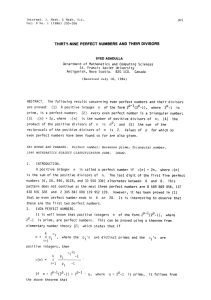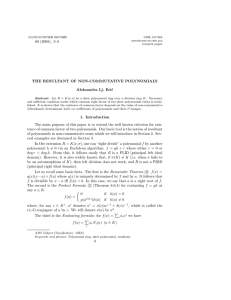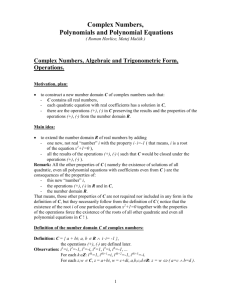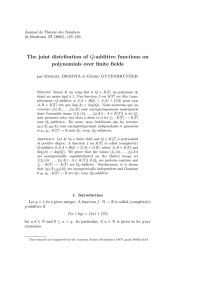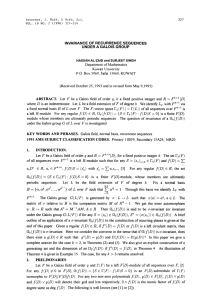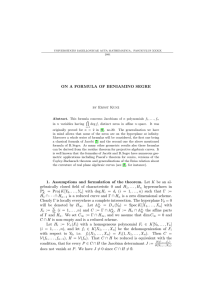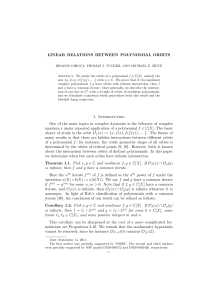Odd perfect polynomials over F
advertisement
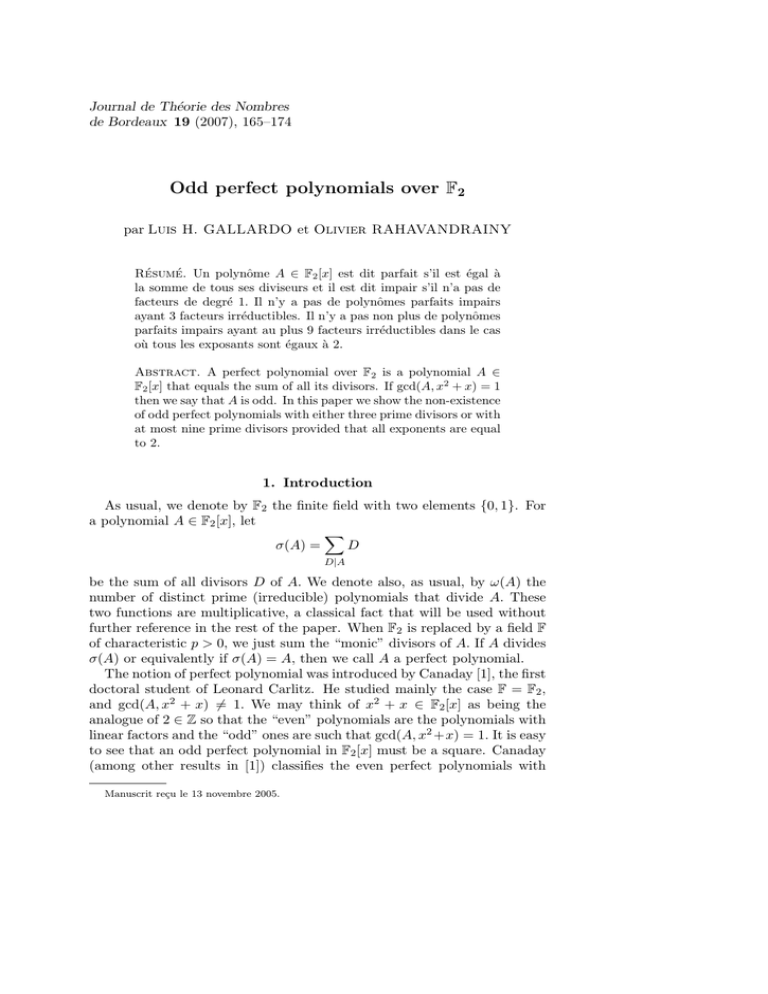
Journal de Théorie des Nombres
de Bordeaux 19 (2007), 165–174
Odd perfect polynomials over F2
par Luis H. GALLARDO et Olivier RAHAVANDRAINY
Résumé. Un polynôme A ∈ F2 [x] est dit parfait s’il est égal à
la somme de tous ses diviseurs et il est dit impair s’il n’a pas de
facteurs de degré 1. Il n’y a pas de polynômes parfaits impairs
ayant 3 facteurs irréductibles. Il n’y a pas non plus de polynômes
parfaits impairs ayant au plus 9 facteurs irréductibles dans le cas
où tous les exposants sont égaux à 2.
Abstract. A perfect polynomial over F2 is a polynomial A ∈
F2 [x] that equals the sum of all its divisors. If gcd(A, x2 + x) = 1
then we say that A is odd. In this paper we show the non-existence
of odd perfect polynomials with either three prime divisors or with
at most nine prime divisors provided that all exponents are equal
to 2.
1. Introduction
As usual, we denote by F2 the finite field with two elements {0, 1}. For
a polynomial A ∈ F2 [x], let
X
σ(A) =
D
D|A
be the sum of all divisors D of A. We denote also, as usual, by ω(A) the
number of distinct prime (irreducible) polynomials that divide A. These
two functions are multiplicative, a classical fact that will be used without
further reference in the rest of the paper. When F2 is replaced by a field F
of characteristic p > 0, we just sum the “monic” divisors of A. If A divides
σ(A) or equivalently if σ(A) = A, then we call A a perfect polynomial.
The notion of perfect polynomial was introduced by Canaday [1], the first
doctoral student of Leonard Carlitz. He studied mainly the case F = F2 ,
and gcd(A, x2 + x) 6= 1. We may think of x2 + x ∈ F2 [x] as being the
analogue of 2 ∈ Z so that the “even” polynomials are the polynomials with
linear factors and the “odd” ones are such that gcd(A, x2 +x) = 1. It is easy
to see that an odd perfect polynomial in F2 [x] must be a square. Canaday
(among other results in [1]) classifies the even perfect polynomials with
Manuscrit reçu le 13 novembre 2005.
Luis H. Gallardo, Olivier Rahavandrainy
166
three irreducible factors, leaving open the classification of the odd ones.
Moreover, in the special case when A is a product of squares of primes P in
F2 [x] he proves the non-existence of odd perfect polynomials when all such
P ’s are of the same degree [1, Theorem 18], and announces without proof
[1, Theorem 21] that P ≡ 1 mod x2 + x + 1, and that P has even degree.
In our papers [3] and [4] we worked on polynomials with coefficients in
an extension field of F2 , while here we come back to the original problem
(i.e., the study of perfect polynomials over the ground field F2 ), extending
some results in [1] mentioned above.
The object of this paper is to prove two results:
a) There are no odd perfect polynomials A with three prime factors,
i.e., of the form A = P a Qb Rc where P, Q, R are distinct irreducible
(and non-linear) polynomials in F2 [x] and a, b, c are positive integers.
b) If A is an odd perfect polynomial which is a product of squares of
primes, then ω(A) ≥ 10. Moreover, every prime divisor Q of such A
has even degree d ≥ 30, and satisfies: Q ≡ 1 mod x2 + x + 1.
A useful lemma for both results a) and b), is a generalization of a result
of Beard [2] (see section 2) about the degrees of the possible prime factors
of A. Also some general lemmata required for b) (see section 4) may also
have some interest in their own right.
It just remains to observe two things. First of all, with a) available, the
complete list of perfect polynomials A with ω(A) ≤ 3 over F2 is (see [1]):
{x2
n −1
(x + 1)2
n −1
, x2 (x + 1)(x2 + x + 1), x(x + 1)2 (x2 + x + 1),
x4 (x + 1)3 (x4 + x3 + x2 + x + 1), x3 (x + 1)4 (x4 + x3 + 1)}
where n > 0 is a positive integer.
Secondly, the congruence in b), (in which we may think of the modulus
2
x + x + 1 as the analogue of the number 3 ∈ Z ) seems insufficient to
bar polynomials from being perfect. This is in contrast to the case of
integers. Indeed, already in 1937, Steuerwald [6] proved by a clever use of
congruences modulo 3 that there are no odd perfect numbers of the form
n = p4k+1 p21 · · · p2r where p ≡ 1 mod 4 is a prime number, k ≥ 0 is a
non-negative integer, r > 0 is a positive integer and p1 < p2 < · · · < pr are
odd prime numbers.
2. Some useful facts
We denote by N the set of non negative integers. In this section we recall,
and present, some necessary results for the next sections.
First of all, we recall two lemmas obtained by Canaday [1] over F2 . Their
proofs work in a more general setting.
Odd perfect polynomials
167
Lemma 2.1. (Lemma 5 in [1]) Let F be a perfect field of characteristic 2.
Let P, Q ∈ F[x] and n, m ∈ N be such that P is irreducible and σ(P 2n ) =
1 + · · · + P 2n = Qm . Then m ∈ {0, 1}.
The following lemma follows from the proof of Lemma 6 in [1]:
Lemma 2.2. Let F be a perfect field of characteristic 2. Let P, Q ∈ F[x] and
n, m ∈ N be such that P is irreducible, m > 1 and σ(P 2n ) = 1 + · · · + P 2n =
Qm C for some C ∈ F[x]. Then
deg(P ) > 2 deg(Q).
We shall deal with three types of primes:
Definition. Let F be a field. Let A ∈ F[x] be a polynomial. A prime
divisor P of A is called a minimal (resp. maximal) prime of A if it has
minimal (resp. maximal) degree. When the prime divisor P is neither
minimal nor maximal we call it a medium prime of A.
We are now ready to present the following lemma [4, Lemma 2.5] that
improves a result of Beard et al., [2, Theorem 7]:
Lemma 2.3. Let F be a field of characteristic p > 0. Let A ∈ F[x] be
a perfect polynomial. Then the number of monic minimal primes of A is
divisible by p.
Proof. Let p1 , . . . , pr be the list of all monic minimal primes of A. Since
A = σ(A), we have:
0=
X
d |A, d6=A
d=
r
X
A
+ ···
pi
i=1
It follows that the leading coefficient of the sum
proves the lemma.
Pr
A
i=1 pi
must be zero. This
3. Perfect polynomials in F2 [x] of the form: A = P h Qk Rl
By Lemma 2.3, we may suppose deg(P ) = deg(Q) < deg(R).
So, P and Q (and h, k) play symmetric roles. If deg(P ) = deg(Q) = 1,
so that A is even, see Canaday’s results in [1] and the Introduction. If
deg(P ) = deg(Q) ≥ 2, so that A is odd, we have:
Theorem 3.1. There are no perfect polynomials A in F2 [x] with ω(A) = 3
irreducible factors P, Q, R with degrees all ≥ 2.
168
Luis H. Gallardo, Olivier Rahavandrainy
Proof. If A = P h Qk Rl is perfect then, by using the multiplicativity of σ,
we have:
1 + · · · + P h = Qa Rb ,
1 + · · · + Qk = P c Rd ,
1 + · · · + Rl = P e Qf ,
where c + e = h, a + f = k, b + d = l.
Case in which one of h, k, l is odd:
Suppose that h is odd. Since P (0) = 1, we have: 1 + · · · + P (0)h = 0.
So, the monomial x divides 1 + · · · + P h and then we have either Q = x or
R = x, which is impossible. The same fact happens if k or l is odd.
Case in which h, k, l are all even:
By Lemma 2.2, we have 0 ≤ a, b, c, d ≤ 1. If b = 0, then a = 1 by Lemma
2.1 and thus h = 1, which is impossible, hence b = 1. Analogously, we have
d = 1, so that l = b + d = 2.
- If a = c = 1, then h = k, e = h − 1 = k − 1 = f . So, 1 + R + R2 = (P Q)e .
Thus, by Lemma 2.1, e = 1 and h = k = 2. We have then
1 + P + P 2 = QR,
1 + Q + Q2 = P R,
1 + R + R2 = P Q.
Thus, P, Q and R have the same degree and R = P +Q+1, a contradiction.
- If a = 0, c = 1, then
1 + · · · + P h = R, 1 + · · · + Qk = P R.
So, h deg(P ) = deg(R) = k deg(Q) − deg(P ) = (k − 1) deg(P ). Thus h =
k − 1, which is impossible since h and k are both even.
- For a = 1, c = 0 the proof is analogous.
- If a = c = 0, then h = k = e = f , l = 2. So 1 + R + R2 = (P Q)e , with e
even. This is impossible by Lemma 2.1.
4. Odd perfect polynomials that are a product of
squares of primes
Here, we present some general results about a possible odd perfect polynomial A ∈ F2 [x], which satisfies certain conditions.
Odd perfect polynomials
169
Definition. An odd perfect polynomial A ∈ F2 [x] is called “special perfect”
if it is a product of ω(A) = m primes pi ∈ F2 [x] of degree di with exponents
all equal to 2:
A = p21 · · · p2m , where 2 ≤ d1 ≤ . . . ≤ dm .
First of all, we present a simple, but useful result.
Lemma 4.1. Let P, Q ∈ F2 [x] be two distinct primes of the same degree d.
If Q divides σ(P 2 ) then P does not divide σ(Q2 ).
Proof. Assume that σ(P 2 ) = 1 + P + P 2 = QC and that σ(Q2 ) = P B
for some polynomials C, B ∈ F2 [x]. Then the first equality implies P 6≡ 1
(mod Q) and P 3 ≡ 1 (mod Q). Thus, the second equality implies B ≡ P 2
(mod Q). It follows that B 2 + B + 1 ≡ 0 (mod Q). Therefore, Q divides
σ(P 2 ) + B 2 + B + 1 = (P + B)(P + B + 1). This is impossible since
deg(P + B) < deg(B) = deg(P ) = d, and deg(P + B + 1) < d.
Our second lemma deals with maximal prime divisors.
Lemma 4.2. Let P ∈ F2 [x] be a maximal prime of a special perfect polynomial A = p21 · · · p2m ∈ F2 [x], with w(A) = m. Let r = 2s be the number of minimal primes of A. Then, there exists an unique couple (i, j),
i, j ∈ {1, . . . , m} such that:
a) pj 6= P, d1 < di < dj = deg(pj ) = deg(P ) = dm . In other words, pj
is maximal while pi is medium;
b) P | p2i + pi + 1 and P | p2j + pj + 1, so that P = pi + pj + 1 ;
c) if 1 + pi + p2i = P R then 0 < deg(R) < di so that dm < 2di .
Proof. a) and b): We may assume that P = pm . If p2m divides some σ(p2i )
for some i < m, then 2dm ≤ 2di . So, dm = di and p2m = p2i + pi + 1. This
implies that
pi = (pm + pi + 1)2
is a square, which is impossible. So, pm appears in exactly two σ(p2k ), say
for k ∈ {i, j} with i < j < m, di ≤ dj :
pm | p2i + pi + 1, pm | p2j + pj + 1.
This implies that pm divides the product π = (pi + pj )(pi + pj + 1) since
(p2i + pi + 1) + (p2j + pj + 1) = π. So, dm ≤ dj , i.e., dj = dj+1 = . . . = dm .
If di = dj then pi + pj and pi + pj + 1 both have degree < dj and since
pm divides one of them, we obtain the contradiction: dm < dj = dm .
Consequently, di < dj . Since pm divides the product (pi + pj )(pi + pj + 1)
and deg(pm ) = dm = dj = deg(pi + pj ) = deg(pi + pj + 1), we derive either
pm = pi + pj + 1 or pm = pi + pj . The second possibility does not happen
because pi + pj is not irreducible.
170
Luis H. Gallardo, Olivier Rahavandrainy
Clearly pm 6= σ(p2j ) since dm < 2dm while if pm = σ(p2i ) then we immediately have the contradiction pj = p2i . So, pm divides strictly σ(p2i ) and
σ(p2j ).
Now we prove that d1 < di . Suppose that the contrary holds: di = d1 .
One has:
pm Q = p2i + pi + 1
so that deg(Q) = 2d1 −dm < d1 . This implies Q = 1. But this is impossible,
since pm divides σ(p2i ) strictly.
c): We have just seen that ρ = deg(R) = 2di − dm > 0 so that dm < 2di .
Moreover, trivially, ρ = 2di − dm < di since di < dm .
The uniqueness of the couple (i, j) follows from the fact that the maximal
prime P appears exactly two times in σ(A) = A.
Corollary 4.3. Let A be a special perfect polynomial. Then, for every
maximal prime P of A, and for every minimal prime Q of A, P does not
divide σ(Q2 ).
Proof. If P is a maximal prime, then by Lemma 4.2, P divides some σ(R2 )
and some σ(S 2 ), where R is maximal and S is medium. So, P cannot divide
σ(Q2 ).
Corollary 4.4. Let A be a special perfect polynomial, let t be the number
of maximal primes of A, and let u be the number of medium primes of A.
Then u ≥ t ≥ 3.
Proof. By part a) of Lemma 4.2, there are at least 2 maximal primes, i.e.,
t ≥ 2. Assume that t = 2 so that pm and pm−1 are the two maximal
primes of A. By our preceding argument there are two indices k < m − 1
and l < m − 1 such that pm divides gcd(σ(p2m−1 ), σ(p2k )) and pm−1 divides
gcd(σ(p2m ), σ(p2l )). This is impossible by Lemma 4.1. In other words, we
have proved that t ≥ 3, i.e., that A has at least three maximal primes. If, for some medium prime pk , two maximal primes P, Q divide the same
σ(p2k ), then P Q divides also σ(p2k ). This is impossible since 2dm > 2dk . So,
u ≥ t, thereby finishing the proof of the corollary.
Corollary 4.5. Let A be a special perfect polynomial with exactly three
maximal primes P, Q, R. Assume that P divides σ(Q2 ). Then Q divides
σ(R2 ) and R divides σ(P 2 ). Moreover, let P1 , Q1 , R1 be medium prime
divisors of A such that P divides σ(Q21 ), Q divides σ(R12 ), R divides σ(P12 ),
and deg(P1 ) ≤ deg(Q1 ) ≤ deg(R1 ), then
1 = P1 + Q1 + R1 .
In particular,
deg(P1 ) < deg(Q1 ) = deg(R1 ).
Odd perfect polynomials
171
Proof. It follows from Lemma 4.2 and Lemma 4.1 that Q divides σ(R2 )
and that R divides σ(P 2 ). Thus, we get
P = Q + Q1 + 1,
Q = R + R1 + 1,
and
R = P + P1 + 1.
By summing both sides of these three equalities we obtain
1 = P1 + Q1 + R1 .
Thus, the inequality deg(P1 ) < deg(Q1 ) = deg(R1 ) holds.
Our third lemma deals with minimal prime divisors.
Lemma 4.6. Let P ∈ F2 [x] be a prime divisor of a special perfect polynomial A. If S = σ(P 2 ) = 1 + P + P 2 is prime then S is not a maximal
prime. Moreover, assume that P is minimal and that S is not prime then:
a) ω(S) = 2, more precisely S = 1 + P + P 2 = QR where Q and R are
two distinct minimal primes of A;
b) P does not divide σ(Q2 ) σ(R2 ).
Proof. Assume that S is prime. If S is maximal, then it follows from
Corollary 4.3 that S divides σ(P 2 ) for some medium prime P. According
to Lemma 4.2 c), S must be a proper divisor of σ(P 2 ), a contradiction.
We assume now that P is minimal and that S is not prime. We can write
1 + P + P2 =
r
Y
Qi ,
i=1
with Qi prime divisor, deg(Qi ) ≥ deg(P ), r ≥ 2. So, r = 2 and deg(Q1 ) =
deg(Q2 ) = deg(P ). Moreover, Q1 6= Q2 since P is not a square.
The result b) follows from a) and from Lemma 4.1.
5. ω(A) ≥ 10 and d1 ≥ 30 for special perfect polynomial A
Let A ∈ F2 [x] be a special perfect polynomial. Our first result, namely
ω(A) ≥ 10, will be proved in two steps. Firstly, the next lemma will show
that ω(A) ≥ 8 and secondly, we will prove that ω(A) 6= 8.
Lemma 5.1. Let A ∈ F2 [x] be a special perfect polynomial. Then ω(A) ≥ 8.
Proof. It follows from corollary 4.4 that A has at least 6 prime divisors,
three maximal and the other three medium. Lemma 2.3 guarantees the
existence of at least 2 minimal primes of A. So, ω(A) ≥ 8.
The case ω(A) = 8 is settled by
172
Luis H. Gallardo, Olivier Rahavandrainy
Lemma 5.2. There is no special perfect polynomial A ∈ F2 [x] with
ω(A) = 8.
Proof. Assume that ω(A) = 8. If A has more than 2 minimal primes, then
Lemma 4.2 implies that ω(A) > 8. So, by Lemma 2.3, A has r = 2 minimal
primes p1 and p2 . From Lemma 4.6 it follows that σ(p21 ) and σ(p22 ) are also
primes. Following Lemma 4.2 the only cases that remain to be studied are
those of the shape A = p21 · · · p28 where p1 and p2 are minimal primes, p3 ,
p4 , p5 , are medium primes and p6 , p7 , p8 , are maximal primes. Moreover,
σ(p21 ) and σ(p22 ) must belong to {p3 , p4 , p5 } (see Corollary 4.3). Observe
that Corollary 4.5 implies that the only possibility for the degrees is the
following:
d 1 = d 2 < d3 < d4 = d 5 < d 6 = d 7 = d 8 .
One has p4 = σ(p21 ), p5 = σ(p22 ). We claim that σ(p23 ) = p8 p2 . We may
assume by Lemma 4.2 that p8 divides σ(p23 ). Write p23 + p3 + 1 = p8 M for
some polynomial M ∈ F2 [x]. Clearly, deg(M ) = 2d3 − d6 < d3 so that only
minimal primes can divide M . Take p2 as a divisor of M and set M = p2 N
for some N ∈ F2 [x]. Thus, deg(N ) = 2d3 − d6 − d1 < d3 − d1 < d1 since
d3 < d4 = 2d1 . So, N = 1. In other words, one has p23 + p3 + 1 = p8 p2 ,
thereby proving the claim. So, the relations
d1 < d3 < d4 = 2d1
and
d8 = 2d3 − d1 < 3d1
hold. Following Lemma 4.2, set
p41 + p1 + 1 = σ(p24 ) = p7 A, p42 + p2 + 1 = σ(p25 ) = p6 B,
with suitable polynomials A, B ∈ F2 [x]. It follows from Lemma 4.2 c) that
A may have only p2 , p3 as prime factors and that B may have only p1 , p3
as prime factors. But
2d1 = d4 < d7 = d6 = d8 < 3d1 ,
so that p2 does not appear as a factor in A, and p1 does not appear as a
factor in B, i.e., A = B = p3 and consequently
σ(p24 ) = p7 p3 , σ(p25 ) = p6 p3 .
By taking degrees in both sides of the equalities above we obtain d3 + d6 =
4d1 which gives, together with d6 = 2d3 − d1 ,
5
7
d3 = d1 , d 6 = d1 .
3
3
From Lemmas 4.2 and 4.1 we obtain
σ(p26 ) = p8 K, σ(p27 ) = p6 L, σ(p28 ) = p7 M,
Odd perfect polynomials
173
for some polynomials K, L, M ∈ F2 [x]. It follows that
7
deg(K) = deg(L) = deg(M ) = d1 .
3
Observe that the only primes available to be factors of these polynomials
are p5 , p4 , p2 once, and p1 twice. But all these polynomials have degrees
that are integral multiples of d1 , a contradiction.
In order to prove our second result, namely, d1 ≥ 30, we shall provide
proofs for two non proven results announced by Canaday (see [1, Theorem
21]). These results, together with a run of a Maple program, will prove the
result.
Lemma 5.3. (Theorem 21 in [1]) Let A ∈ F2 [x] be a special perfect polynomial. Let P ∈ F2 [x] be a prime divisor of A. Then
a) P is congruent to 1 modulo x2 + x + 1 ;
b) deg(P ) is even.
Proof. First of all, by Lemma 2.3, Q = x2 + x + 1 cannot divide A since it
is the only prime polynomial of degree 2 in F2 [x]. Let F2 be an algebraic
closure of F2 , and let α ∈ F2 be such that α2 + α + 1 = 0. We have
P (α)P (α2 ) 6= 0, since P (α) = 0 implies that Q = (x − α)(x − α2 ) divides
P so that P = Q, a contradiction. Assume now that P (α) ∈ {α, α2 }. This
implies (1 + P + P 2 )(α) = 0 and so, Q divides σ(A) = A, a contradiction.
It follows that P (α) = 1 = P (α2 ) so that
P ≡1
(mod x2 + x + 1).
Set F4 = F2 [α]. If P remains prime in F4 [x] then from the equality A = σ(A)
we deduce that P divides some σ(R2 ) = 1 + R + R2 = (R + α)(R + α2 ). We
may assume that P divides R+α in F4 [x]. Thus, P (A+Bα) = R+α for some
A, B ∈ F2 [x]. In particular, we get the contradiction P B = 1. Hence, P
splits in F4 [x], i.e., it has the form P = (C +Dα)(C +Dα2 ) = C 2 +CD+D2 ,
for some C, D ∈ F2 [x], so that deg(P ) is even. This finishes the proof of
the lemma.
The following corollary is used for computations:
Corollary 5.4. Let A ∈ F2 [x] be a special perfect polynomial. Let P ∈ F2 [x]
be a minimal prime divisor of A. Then P, all prime divisors Q of σ(P 2 ), all
prime divisors R of σ(Q2 ) and all prime divisors of σ(R2 ) are congruent
to 1 (mod x2 + x + 1) and have even degrees.
Our main results are summarized in the next theorem:
174
Luis H. Gallardo, Olivier Rahavandrainy
Theorem 5.5. Let A ∈ F2 [x] be a special perfect polynomial. Let P ∈ F2 [x]
be a minimal prime divisor of A. Then:
a) ω(A) ≥ 10;
b) d1 = deg(P ) ≥ 30.
Proof. By corollary 4.4, A has at least 6 prime divisors, hence from Lemma
2.3 (the number of monic minimal primes is even) and Lemma 5.2 one gets
ω(A) ≥ 6 + 4 = 10 proving a). Now b) is obtained by running a Maple
program that uses Corollary 5.4. All possible P ’s with degree up to 28
were tested, and the conclusion of the corollary was always violated. The
computation used 126 hours of idle time on a sun4u sparc SUNW, Ultra
Enterprise machine, running the command line version of Maple 6.
References
[1] E. F. Canaday, The sum of the divisors of a polynomial. Duke Math. J. 8 (1941), 721–737.
[2] T. B. Beard Jr, James. R. Oconnell Jr, Karen I. West, Perfect polynomials over
GF (q). Rend. Accad. Lincei 62 (1977), 283–291.
[3] L. Gallardo, O. Rahavandrainy, On perfect polynomials over F4 . Portugaliae Mathematica 62 - Fasc. 1 (2005), 109–122.
[4] L. Gallardo, O. Rahavandrainy, Perfect polynomials over F4 with less than five prime
factors. Portugaliae Mathematica 64 - Fasc. 1 (2007), 21–38.
[5] Rudolf Lidl, Harald Niederreiter, Finite Fields, Encyclopedia of Mathematics and its
applications. Cambridge University Press, 1983, (Reprinted 1987).
[6] Rudolf Steuerwald, Verschärfung einer notwendigen Bedingung für die Existenz einer
ungeraden vollkommenen Zahl. S. B. math.-nat. Abt. Bayer. Akad. Wiss München (1937),
69–72.
Luis H. Gallardo
Université de Brest
6, Avenue Le Gorgeu, C.S. 93837
29238 Brest cedex 3, France
E-mail : Luis.Gallardo@univ-brest.fr
Olivier Rahavandrainy
Université de Brest
6, Avenue Le Gorgeu, C.S. 93837
29238 Brest cedex 3, France
E-mail : Olivier.Rahavandrainy@univ-brest.fr
